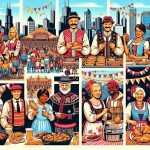
In America, a place where so many cultures come together, keeping Polish traditions alive is a strong sign of how important cultural identity is, even when the world is becoming more connected. From celebrating Polish holidays, enjoying its delicious food, keeping up with traditional crafts, to dancing and listening to Polish music, these activities are not just about remembering the past. They are a serious effort to keep a culture going.
But, as communities change and new generations come along, it gets harder to keep these traditions. This leads us to ask: how can Polish-Americans find the right balance between fitting in with the larger American culture and keeping their own traditions strong, making sure they don’t just survive but actually flourish in the US?
Let’s talk about this in a simple and friendly way. Keeping Polish culture alive in the US is like walking a tightrope. On one side, there’s the big, wide American culture that everyone is a part of. On the other, there’s the rich, colorful tapestry of Polish heritage that people want to hold onto. The trick is to walk that line carefully, enjoying the best of both worlds. This means finding creative ways to celebrate Polish traditions in a way that feels relevant today, passing these customs down through families, and maybe even sharing them with friends who aren’t Polish.
The goal? To make sure Polish culture not only sticks around but also shines in the multicultural mix of America.
Celebrating Polish Festivals
In the United States, Polish festivals are a lively demonstration of the culture and community spirit among Polish Americans. These events are not just fun; they’re a way for people of Polish descent to stay connected to their roots and celebrate their heritage. From religious holidays to historical remembrances and community get-togethers, these festivals cover a wide range of activities that all have one thing in common: celebrating Polish culture.
Let’s dive into what makes these festivals so special. For starters, many include traditional Polish food, like pierogi and kielbasa, that you might not find easily elsewhere in the US. Then there’s the music and dance, with folk bands and polka music often taking center stage, creating a lively atmosphere that’s hard to resist. But it’s not just about having a good time. These festivals also include events that honor important historical dates for Poland, helping younger generations understand and appreciate their history.
One great example is the annual celebration of Polish Constitution Day. This event marks the signing of the Constitution of May 3, 1791, and is celebrated in many Polish communities across the United States with parades, speeches, and cultural performances. It’s a vivid reminder of Poland’s fight for freedom and independence, and it’s a source of pride for many Polish Americans.
These festivals also play a crucial role in keeping Polish traditions alive in the US. By teaching children traditional dances, serving authentic Polish dishes, and speaking the Polish language, these events ensure that Polish culture is passed down through generations. This is especially important in a country as diverse as the United States, where maintaining a connection to one’s cultural heritage can be challenging.
Preserving Culinary Heritage
Polish Americans play a crucial role in keeping their cultural heritage alive, especially through cooking and sharing traditional Polish dishes. This is more than just about making food; it’s a way to pass down culture and knowledge from one generation to the next. Dishes like pierogi (dumplings), kielbasa (sausage), and bigos (hunter’s stew) are not just meals. They carry stories from different parts of Poland, reflect various seasons, and honor the many people who have made and shared these recipes over the years.
Cooking these traditional meals, especially during holidays and special occasions, helps Polish Americans feel connected to Poland. It’s a practical way to keep their cultural traditions, language, and customs alive in their daily lives. This connection ensures that Polish culinary heritage continues to be a vibrant part of the diverse American culture.
Let’s consider pierogi, for example. These dumplings can be filled with anything from potatoes and cheese to fruits, and making them often involves family or community gatherings. The process is as meaningful as the product, emphasizing the importance of togetherness and sharing. It’s a hands-on way to teach younger generations about their ancestry while enjoying delicious food.
The Art of Polish Crafts
Polish crafts play a crucial role in the lives of Polish Americans, acting as a bridge to their cultural heritage. These crafts, including Wycinanki (paper cutting) and Pisanki (Easter egg painting), are more than just art. They carry the stories, beliefs, and history of the Polish people. Passed down through generations, these crafts showcase the creativity and resilience of the Polish spirit.
For example, Wycinanki involves cutting intricate designs into paper, a skill that requires patience and precision. Pisanki, on the other hand, is the art of painting detailed patterns on Easter eggs, each design symbolizing different aspects of life and nature. These crafts are not just for decoration; they are a way for Polish Americans to maintain a connection with their roots.
In the American cultural landscape, Polish crafts add a unique flavor, representing the diverse heritage of the nation. They also serve as a unifying symbol for Polish Americans, reminding them of their shared history and values. By practicing these crafts, they keep their cultural traditions alive and pass them on to the next generation.
Moreover, these crafts offer a creative outlet and a way to celebrate important occasions and festivals. For instance, Pisanki eggs are a popular gift during Easter, symbolizing rebirth and new beginnings. Similarly, Wycinanki decorations are often used during Christmas and other celebrations, adding a touch of Polish tradition to these events.
Music and Dance Traditions
Polish Americans hold dear a variety of music and dance traditions that reflect their cultural heritage and history. These traditions aren’t just for show; they’re a window into the Polish experience, telling stories of where they’ve come from and what they’ve been through. Music and dance, like the lively polkas and mazurkas or the emotive folk songs, are more than entertainment. They are a form of storytelling, keeping alive the memories of the homeland and the battles and victories of the past. Through careful preservation and adaptation, these cultural practices remain relevant and lively, even as society changes.
For example, ethnographic studies show the effort Polish American communities put into keeping these traditions alive. They update and adapt them without losing the essence, making sure they continue to resonate with both older and younger generations. This is evident in how these traditions are celebrated in various settings, from big festivals that draw crowds, to intimate family gatherings and local community events. These occasions are not just about maintaining traditions; they’re about celebrating Polish identity in the diverse cultural landscape of America.
Moreover, these music and dance practices offer a direct connection to Polish culture for those who may be generations removed from their immigrant ancestors. They serve as a dynamic way to express identity, connect with others who share this heritage, and educate those who are curious about Polish culture. In the process, they enrich the multicultural fabric of American society, showing how diversity and tradition can coexist and enhance community life.
Community and Family Bonds
Polish Americans deeply value their music and dance traditions, which play a significant role in bringing people together. More importantly, they maintain strong connections within their communities and families, crucial for keeping their cultural heritage alive. These connections aren’t just a backdrop; they’re at the heart of sustaining Polish culture for future generations.
At various community events, including religious festivals, traditional meals, and commemorations, Polish Americans come together. These gatherings are essential for practicing and upholding their cultural standards and beliefs. Here, people of all ages share and learn the Polish language, customs, and stories, helping to bind each person to a shared cultural story.
Families play a crucial role in this process. By following daily traditions and rituals at home, they instill a sense of Polish identity in the next generation. It’s within the family that many learn the values and practices that define their culture. For example, preparing and sharing a traditional Polish meal during holidays can be a powerful way of connecting with one’s heritage and passing it on to children.
In essence, the strength of Polish heritage in America leans heavily on the connections within communities and families. These relationships provide a supportive framework that keeps Polish culture vibrant among its diaspora. By actively participating in cultural practices and passing them on, Polish Americans ensure that their rich heritage continues to thrive across generations.
Conclusion
To sum it up, keeping Polish traditions alive in America is all about doing a bunch of cool stuff.
We’re talking about throwing festivals, cooking up traditional Polish meals, getting hands-on with old-school crafts, and keeping the music and dance moves from the homeland alive.
It’s not just about remembering where we come from; it’s about bringing people together, whether that’s family or the whole community.
By doing all this, Polish-Americans add their unique flavor to America’s cultural mix, showing how important it is to keep our traditions going in today’s global world.






Comments are closed.